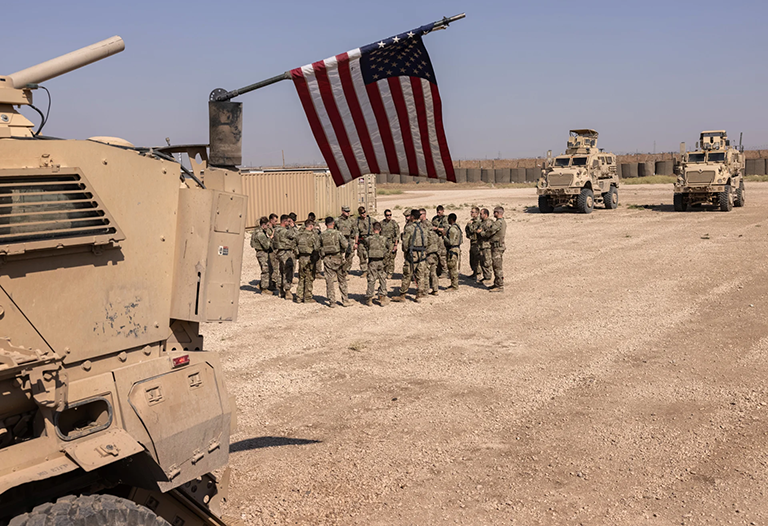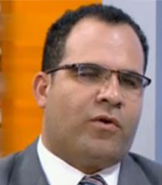Recent reports have brought to light potential threats from Iran against US forces stationed in Syria. The concerns have arisen particularly in response to Washington’s decision to maintain a presence in Syria, citing the ongoing mission to combat the terrorist organization “ISIS” as unfinished. These developments have unfolded amidst a controversy surrounding the relocation of the US Army’s “HIMARS” defense system to northern Syria. This move has sparked objections from Turkey, who claim that the system has been handed over to the “Syrian Democratic Forces” (SDF) militia. However, Washington has denied these allegations and affirmed that the transfer of the system to Syria is legitimate, serving the defense needs of the United States. This denial supports the validity of the leaks suggesting the presence of an existential threat to US forces in Syria.
Nature of the Threats
Earlier this month, The Washington Post published a report stating that Iran is intending to intensify its attacks against US forces in Syria. Additionally, the report revealed that Iran is collaborating with Russia to develop a comprehensive strategy aimed at forcing American troops out of the region. The newspaper also disclosed documents it had acquired, which suggest that Tehran is providing training and weaponry to its loyal fighters in Syria, specifically instructing them to employ more potent armor-piercing bombs in roadside attacks. The objective of these actions is to initiate a new wave of lethal assaults targeting military vehicles and causing harm to American soldiers stationed in Syria.
According to US intelligence officials, the current situation signifies an escalation by Iran in a long-standing proxy war. This escalation involves the development of attacks on American forces in Syria, with the potential for missile and drone strikes.
Among the documents obtained by The Washington Post, one highlights that certain factions within the Syrian Democratic Forces (SDF) procured three armor-piercing explosive devices. These devices were being transported by pro-Iranian elements near the Rumailan area in northeastern Syria, indicating preparations for an imminent attack. Notably, the documents also shed light on Russia’s supportive role in Iran’s campaign against the American presence. While there is no direct evidence of Russia’s involvement in planning the Iranian campaign, US intelligence reveals that an Iranian-Russian meeting occurred in November 2022. The meeting resulted in an agreement to establish a coordination center aimed at leading the campaign against US forces.
Washington’s Calculations
Approximately two days after The Washington Post leaks, John Kirby, the Coordinator for Strategic Communications at the National Security Council in the White House, made an announcement. He stated that the United States has the intention to maintain its military presence in Syria, with around 900 American soldiers, and ensure their complete protection. Kirby emphasized that the US forces will continue their mission to combat ISIS, as there is an ongoing necessity for counterterrorism operations.
Prior to Kirby’s statements, Turkish reports emerged regarding the transfer of the American “HIMARS” system to Syria and its subsequent delivery to the SDF. Turkish officials viewed this as a fresh escalation in the deepening cooperation between the US and the SDF, an organization that Ankara categorizes as a terrorist group. Consequently, this has further heightened tensions between Turkey and the US. Responding to these reports, the spokesperson for the US Central Command acknowledged the accuracy of the information regarding the transfer of the defense system. However, they refuted the claim that it had been handed over to the SDF, asserting that it would remain under American control to enhance defenses in the region.
A Cycle of Escalation
It is worth noting that an unprecedented military escalation between the US and Iran took place in northern Syria last March. This escalation occurred as American deployment points were located in close proximity to positions held by pro-Iranian militias, particularly along the Iraq-Syria border region. US forces strategically positioned themselves in specific areas believed to be utilized by Iran for the transportation of weapons from Iraq to Syria, with a particular focus on the Al-Bukamal area and eastern Deir ez-Zor.
Although reports indicated that Iran had withdrawn from certain areas targeted by US attacks, resulting in a reduction in the escalation cycle, US documents have now revealed that Tehran has replaced some militia groups with the pro-Iranian Syrian Quds Force. This force is responsible for the preparation and deployment of ground mines.
In this context, it is noteworthy that earlier this year, the Syrian regime made an announcement stating that Iran would be providing necessary defensive weapons to Syria. Additionally, an Iranian TV report on February 24th indicated a high likelihood of Tehran supplying its ally, Damascus, with radar systems and defensive missiles such as the “15 Khordad” system. The purpose of this support was to strengthen Syrian air defenses, specifically to address the ongoing Israeli attacks on Damascus. There were reports suggesting that Russia had to relocate some of its systems from Syria to Ukraine in order to cover its forces’ movements there. However, it remains undisclosed whether the system transfer actually took place. Nevertheless, leaks from the US indicate a notable concentration of weapon shipments towards areas under Kurdish control.
In this context, the process of mobilization and counter-mobilization between the two parties suggests a new phase of escalation. It is not only limited to Iranian attacks on US deployment sites in Syria but may also extend to the Iraqi arena. In Syria, tactics of “resistance” against US presence in Iraq, like the planting of explosive and armor-piercing devices, are now being transferred to the Syrian arena. As Washington strengthens its defenses in Syria using drones and missiles, there may be a need to deploy additional forces for mine-clearing operations, potentially leading to an increase in US presence.
Furthermore, Washington will enhance its surveillance and monitoring of Iranian weapons entering the Syrian arena from the Iraqi border. At the same time, Israel will take on the responsibility of monitoring weapons arriving in Damascus by air. This could result in increased coordination between the US and Israel, and subsequently impact the rising tensions between Iran and Israel on both the Syrian and Lebanese fronts.
Notable Developments
Throughout the war in Syria, Russia has shown little concern for the attacks Iran has suffered from the United States or Israel. In fact, numerous reports suggest that Russia often responded to Israeli notifications about air strikes targeting Iranian movements. However, the Russian-Ukrainian war may have prompted a shift in Moscow’s stance. Moscow has strengthened its alignment with Tehran on multiple fronts, shifting its focus from Ukraine, which has now become a platform for Iranian “Shahid” marches, to Syria.
Conversely, Turkey is specifically moving closer to this alignment in Syria, while the gap between Turkey and Washington widens due to the Kurdish issue. As a result, Washington will find itself facing a coalition of adversaries comprising the Syrian-Russian-Iranian-Turkish quartet in this region.
It is crucial to recognize that the cooperation between Russia and Iran in the Ukrainian arena has contributed to dealing with unique challenges that have not been encountered recently in Iraq. This is particularly evident in the case of the “Khibiny” system, which Russia has effectively countered through jamming techniques. If such experiences are transferred to Syria, it is conceivable that US forces will face a defensive dilemma.
Moreover, the deployment of mines along the roads on both sides will severely limit the movement of US forces in those areas, making the American mission in the near future extremely difficult. Securing a military presence may not be feasible as Washington claims, unless it is compelled to intensify its presence or consider the alternative scenario of withdrawal.
In conclusion, the center of escalation between Iran and the United States is shifting from Iraq to Syria. This does not imply a reduction in US presence in Iraq, but rather suggests that the Syrian arena may experience a heightened level of escalation within a fragile security environment. Additionally, the coalition of adversaries aiming to weaken Washington and its ally, the “SDF,” further strengthens this hypothesis.


